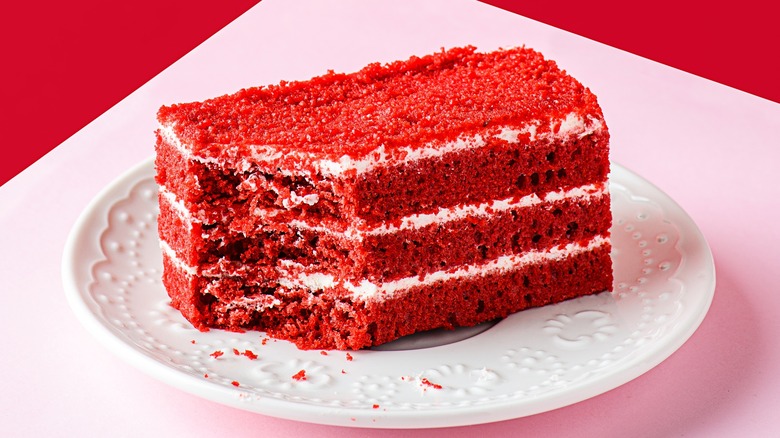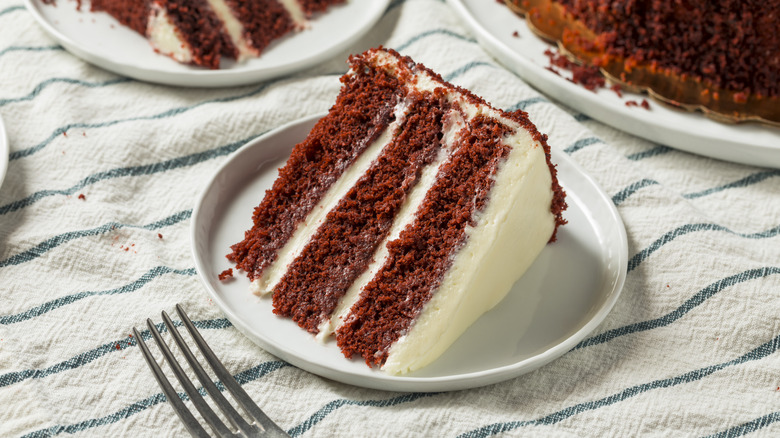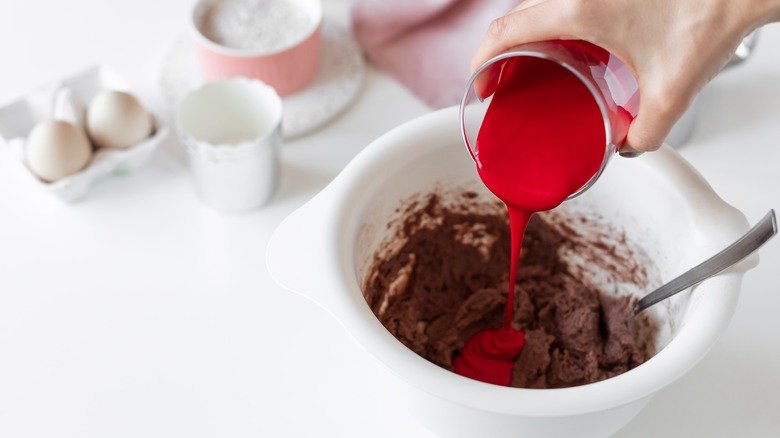What Flavor Is Red Velvet, Anyway?
Red velvet's bright color has a way of puzzling our tastebuds. If you had no other reference point for red velvet cake except its appearance, you might expect it to taste like red fruit, perhaps raspberry or strawberry. But if you've tasted this classic cake variety, with its delicate red crumb and rich cream cheese frosting, you know that's not even close. In reality, red velvet's flavor is a mild chocolate crossed with vanilla, plus something extra you might have trouble placing.
Don't feel bad if you weren't sure what flavor red velvet was until now. Flavor and color have an odd relationship. Think of blue raspberry, a taste that seems more about color than actual raspberries, or bright red grenadine, which evokes images of cherries even though it doesn't contain them. Interestingly, research also suggests that color can set our expectations before the first bite or sip. For example, in one study published in the journal Flavour, researchers highlighted that people tended to associate red foods with sweetness, which sets the stage for exploring red velvet's flavor and appeal.
Red velvet's flavor has a lot to do with its history
To understand how a chocolatey vanilla cake became red, we'll have to travel back to the Victorian era. At this point in history, delicate cake flour didn't exist yet, so vinegar was added to cakes to tenderize them and make them more appealing to discerning palates. The result was a soft, silky cake dubbed "velvet cake." Cocoa used to make chocolate cakes at the time was a bit different too, it wasn't alkalized or processed, so this raw cocoa powder (especially its antioxidants) was more sensitive to changes in pH. When bakers mixed vinegary cake mix with cocoa powder, the chemical reaction that occurred made the resulting cake decidedly less chocolate brown and more mahogany. Instead of fighting it, people embraced it, calling it "mahogany cake."
As times changed, so did red velvet. This dessert was an accessible treat during tough times like the Great Depression and World War II since it didn't require a ton of cocoa or any real chocolate (making its ingredients cheap), and could use things like beet juice instead of sugar (which was rationed during war times). As this recipe wound its way through American kitchens, it picked up buttermilk from the South. But alas, when alkalized cocoa powder arrived, the chemical reaction that made cakes red no longer occurred. Luckily, food coloring was invented and people began adding it to their cocoa cakes to give them their familiar red color again.
How red velvet tastes today
In contemporary kitchens, red velvet cake is made from a familiar roster of ingredients — flour, sugar, butter, eggs, and cocoa — and is enhanced by vanilla, buttermilk, vinegar, and (of course) red food coloring. While natural coloring alternatives like beet juice offer a nod to the muted colors of velvet cakes past, their flavor might make your cake taste a little less like chocolate and vanilla and a bit more like, well ... beet. But, if you want to skip the steps involved in gathering these ingredients and whipping up a cake at home, there are also some crowd-favorite red velvet cakes you can snag at your local grocery store.
If you're still thinking that red velvet is basically like chocolate cake but with red food coloring, you're mistaken. Aside from its color, its signature lies in a delicate crumb texture and a flavor that straddles the line between the richness of cocoa and a subtle tang of buttermilk and vinegar. This balance is perfected with the addition of cream cheese frosting, a pairing as iconic as the cake itself. In this light, red velvet is not just a chocolate cake in disguise but a distinct culinary creation that celebrates the art and science of baking.


